David's Astronomy Pages
Notes - Session 629 (2018-09-14)
Notes
(S628)
Notes
Main
Home
Page
Notes
(S630)
David's Astronomy Pages
|
Notes (S628) |
Notes Main |
Home Page |
Notes (S630) |
Main aims
Equipment & Software
Highlights
Summary Plots & Logs
|
Observing Result (2018-09-14, S629) Operations started at 19:04, Sky Flats started at 19:30, with first useful Flats at 19:57 Sky Flats ended at 20:13, First HFD profile collected at 20:47, Automated Operations from 20:56, Job Queue started at 20:56, Several software interruptions (to be listed) Manual Mode from 02:00 to image 21P/Giacobini-Zinner Further HFD Profiles at 04:33 Session Ended/Observatory Closed at 05:09 |
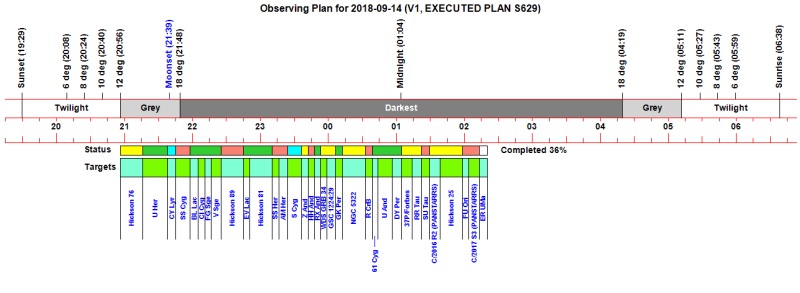 |
| (Observation Status : Green=Completed, Yellow= Partially Completed, Red= Failed) |
|
Night Sky Summary Plot -
2018-09-14 Top axis: Sky Brightness at Zenith (in ADU/s) Lefthand axis: Local Time (hh LT). Righthand axis: Sun Altitude (degs) Data outages at 22:51 (0.25 hours), and 03:41 (10.6 hours) |
 |
Back to Top
AllSky Data and Weather Synopsis
outages. Outages in the generation of AllSky products (all sky images
and Night Summary Plots) and the generation & delivery of weather
synopsis/scorecard information occurred at 22:51. and 03:41 (outages lasted 0.25
and 10.6 hours respectively). Reason: The outages occurred when a critical exception occurred in the main All
Sky Routine (TakeFrameJobs / 'Take Image Series') which persisted even after
attempts to automatically restart the routine 5 times.System.OverflowException: Arithmetic operation resulted in an overflow.
at
CCDApp3_AllSky.globals2.GetWeatherData() in C:\Users\David\Documents\Visual
Studio 2017\Projects\CCDApp3_AllSky\CCDApp3_AllSky\globals.vb:line 71423
at CCDApp3_AllSky.globals2.AllSkyTakeFrames() in C:\Users\David\Documents\Visual
Studio 2017\Projects\CCDApp3_AllSky\CCDApp3_AllSky\globals.vb:line 60123
Line 71423 (sitting within a "With WeatherData..End
With" block) is IV.AvWindDirection (integer)
= .AvWindDirection (Double)
This seems an unlikely exception point unless WeatherData.AvWindDirection
is 'infinity' or some other very large number.
The block has been placed
within a 'Try..Catch.. End Try' block
![]() Fixed
Fixed
 |
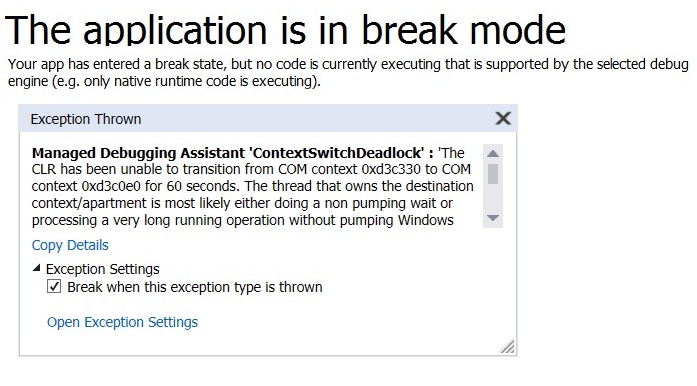 |
| Multiple ASCOM.Utility messages 'The Device does not recognize the command' |
 |
| POTH Hub with missing LST value |
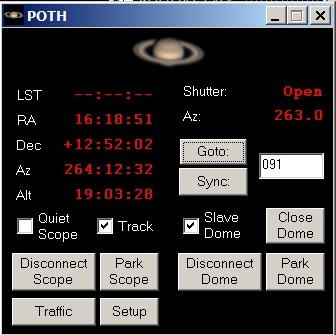 |
| PHD2 Message: PulseGuide command to mount has failed |
 |
Back to Top
The Sky Flats routine was started off with sun at -0.9 deg altitude. Six sets were successfully acquired before the sky became too dark to take flats that would meet ADU target (30,000 +/- 5,000) within 10s exposure (or 15,000 +/-5,000 for 1x1 binning).
Results
| Set |
Filter / Bin Set |
Sun Altitude (deg) |
Exposure (s) |
Av. Count (ADU) |
Target Count (ADU) |
Total Time (incl Slew) (mins) |
Result | |||||
| 1 | Ha, 2x2 | -1.06 to -1.57 | 3.26 to 4.40 | 30158 | 30000 | 5.7 mins | Successful Set (15 frames) | |||||
| 2 | Nd, 1x1 | -1.77 to -2.11 | 10.0 to 10.0 | 11415 | 15000 | - | Sky too dark after 6 frames | |||||
| 3 | Nd, 2x2 | -2.31 to -2.65 | 8.80 to 10.0 | 28137 | 30000 | - | Sky too dark after 8 frames | |||||
| 4 | Nd, 3x3 | -2.81 to -3.38 | 6.08 to 10.0 | 29184 | 30000 | 5.5 mins | Successful Set (15 frames) | |||||
| 5 | Xo, 2x2 | -4.05 to -4.49 | 1.02 to 1.72 | 29473 | 30000 | 8.3 mins | Successful Set (15 frames) | |||||
| 6 | Xo, 3x3 | -4.66 to -5.02 | 1.00 to 1.53 | 29628 | 30000 | 3.9 mins | Successful Set (15 frames) | |||||
| 7 | S, 2x2 | -5.19 to -5.69 | 3.78 to 7.47 | 29069 | 30000 | 5.3 mins | Successful Set (15 frames) | |||||
| 8 | S, 3x3 | -5.85 to -6.35 | 4.10 to 7.88 | 29147 | 30000 | 5.0 mins | Successful Set (15 frames) | |||||
| 9 | C, 1x1 | -6.49 | 10.0 | 4469 | 15000 | - | Sky too dark to start frames |
Notes:
a) Neutral Density (Moon) filter needs to be kicked off earlier
b) a shorter exposure trial (say 0.2s) could be used at the start to test for
and limit/prevent over-saturation of the CCD
c) the optimal order of flats sets (by
filter/binning) is probably best established by measuring ADU collection rates
against the dusk sky, rather than guessing
d) Eventually the routine will be
kicked off by the Observatory Manager itself at a more precisely defined sun
altitude, but at this stage in its
development it was again manually initiated and monitored).
Pictures showing the Master Flats generated from the new sky flats from Session S629 (Flats).
|
Master Flat, Nd filter (3x3) (Average Median for 15 frames ) |
 |
|
Master Flat, Xo filter (3x3) (Average Median for 15 frames ) |
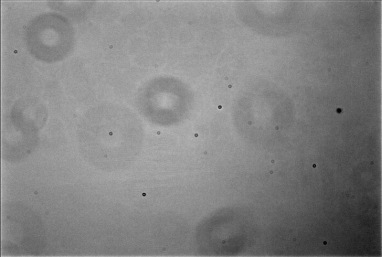 |
|
Master Flat, S filter (3x3) (Average Median for 15 frames ) |
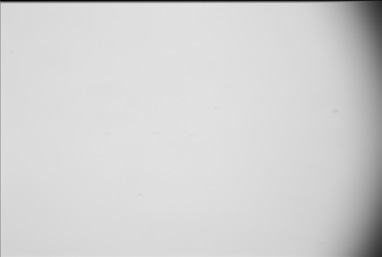 |
|
All Frames 50% original size (CCD Temp -15°C) |
Back to Top
A new subroutine has been written to calculate Half Flux Diameter (HFD) of a star, as an extension to my current Automated Focus Profile routine . In due to course I might switch to refocusing using HFD values if I can get I can make focusing quicker than my existing method based on FWHM measurements. For the moment it is just an initial exploratory look at HFD data and to test my HFD subroutine on live data.
HFD measurements are shown on following profile plots as small cyan circles,
the FHWM measurement are in orange. The best focus position automatically
calculated from the FWHM data is in yellow. Literature suggests that HFD
profiles are V shaped with linear sections in the near focus and far focus
regions with a short curved section in between, (ie through the critical focus
area).
Whilst I can see linear sections either side the profile is not
particularly V shaped, the middle curved section seems quite wide. It could be
that I'm measuring a relatively narrow focus range close to the best focus. A
wider focus range would presumably show longer linear sections making the curved
section look a lot smaller.
| Focus Profiles, including new HFD measurements |
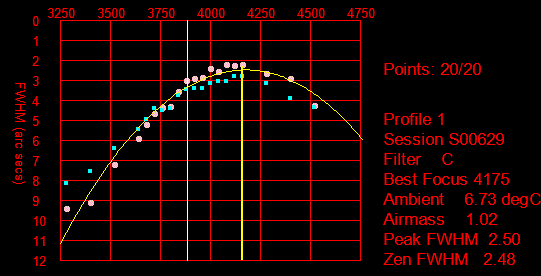 |
 |
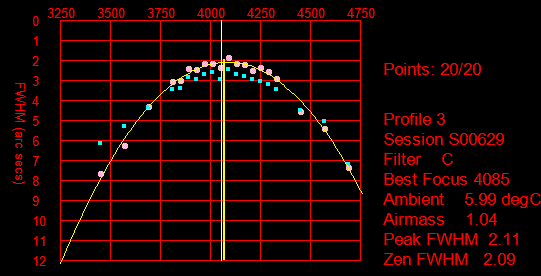 |
 |
 |
|
HFD Profile 5 (26 points) Including supplementary data taken beyond the normal step range The first 6 points and last 5 points are used to define linear sections of the profile |
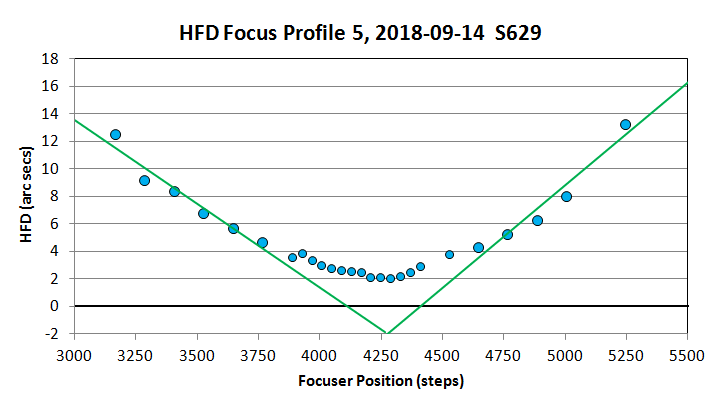 |
The variation in HFD due to seeing was examined by taking 17 images at a single focus position (3850). This dataset gave an average HFD value of 4.30 arc secs (range 3.93 to 5.40 arc secs). 17 images is clearly more than one would practically take at a single focuser position. Taking 3 successive sets of 5 images , showed average HFD values of 4.29, 3.98 and 4.7 arc secs.
The time used to perform a single HFD calculation across all 5 profiles
varied from 5 to 15 seconds (average 10.3s). This is significantly more than the
exposure times of just 1 or 2 seconds used and significantly lengthens the time
taken to measure an entire focus profile.
(This is ok for an
initial coding trial, but for practical application the calculation needs to be
reduced to under 1 second).
Earlier tests had shown that for 1x1 binning an outer radius value of 20 pixels (9 arc secs) was about the optimal size to use (a larger size increases uncertainty in the measurement, whilst a smaller size fails to capture all of the star data for moderately out of focus stars). For badly out of focus stars a much larger outer radius would be needed, but this larger radius would compromise HFD measurements of better focused stars. (It would seem you need to know the HFD value in order to chose the right outer radius value to use in calculation of HFD (a 'chicken & egg' conundrum). A solution might be to use a two stage process, the first step using a standard size outer radius and then a second step with outer radius based on the approximate HFD value from the first step, but this would double the overall time for focusing).
|
HFD Sensitivity to Outer Radius Size HFD measurement of a star taken at two different focus positions using different outer radius sizes The optimal outer radius size appears to be around 20 pixels (9 arc secs) 1x1 binning, 12" LX200GPS/R operating at f/10.4 |
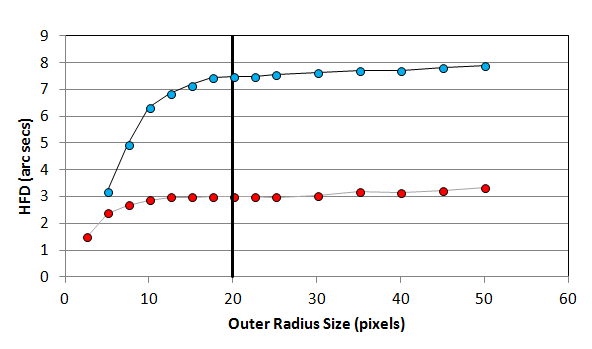 |
Back to Top
To create an animated GIF showing the movement of 21/P I use PaintShopPro5's Animation Shop tool. Unfortunately this tool won't accept files with complex file name formats such as "Comet_21P_Giacobini-Zinner.20180915.im629521.30s.C.bmp". Whilst renamig up to 10 files by hand is ok, renaming 60 image files by hand was going to be a tedious task.
Solution was to use Windows PowerShell in a two set process to remove the first part and then the second part of the name
cd c:/bmp (folder containing my bmp images)
get-childitem *.bmp | foreach { rename-item $_ $_.Name.Replace("Comet_21P_Giacobini-Zinner.20180915.", "") }
get-childitem *.bmp | foreach { rename-item $_ $_.Name.Replace(".30s.C", "") }
This resulted in files with unique simple names like "im629521.bmp" which Animation Shop could successfully import.
Back to Top
A new laptop computer has been acquired for astronomical image processing/analysis, observatory software development and general computing/personal use. The screen on previous laptop has failed on its right hand side and its keypad is gradually failing , however it has a good CPU, good disks and a complte suite of observatory software and will carry on being use as the principal Observatory Computer.
Operating System
The new laptop (Chillblast) is already supplied with Windows 10 Pro.
Software
Installation of software on new computer includes
- Visual Studio 2017
Community
- TheSky6 (version 6.0.0.65)
- CCDSoft5 (version 5.00.201)
-
TPoint (version)
- ASCOM 6.3 (incl POTH.Hub)
- TeleAPI
- LX200GPS/R
Driver
Other reliable general purpose software includes
- ACDSee 4
- PaintShopPro5
- TextPad 4
Issues during installation
- VS2017 wouldn't fire up initially (it
just gives a white screen then disappeared). Reinstalled but same problem.
Finally
after using the Repair option it eventually launched OK.
- CCDSoft producing message about sbigudrv drivers failing to load.
| Critical Components | Software | Data | Notes |
| Live Mail installed from Web download (Live Essentials 2012) | LIve Mail folder copied/moved to new computer | Working | |
| Exported / Imported Contacts as a .csv file | Working | ||
| TheSky6 | TheSky6 installed | .SBD folder copied from /TheSky6/Data/User area | Working |
| TheSky6 folder copied from My Documents/Software Bisque | Working | ||
| FV | |||
CCDSoft5 Process Name had different
captilization in Windows 10 computer compared to earlier Window 7 computer. This
prevented certain CCDApp2 routines from recognising CCDSoft5 process, and
stopped them from performing their expected functions. This was fixed by
modifying the effected code to use a 'UCase' comparison, rather than earlier
specific case comparison.
If
UCase(Proc.MainModule.ModuleName) = "CCDSOFT.EXE" then
Issues during Use
Back to Top
| This Web Page: | Notes - Session 629 (2018-09-14) |
| Last Updated : | 2023-11-26 |
| Site Owner : | David Richards |
| Home Page : | David's Astronomy Web Site |